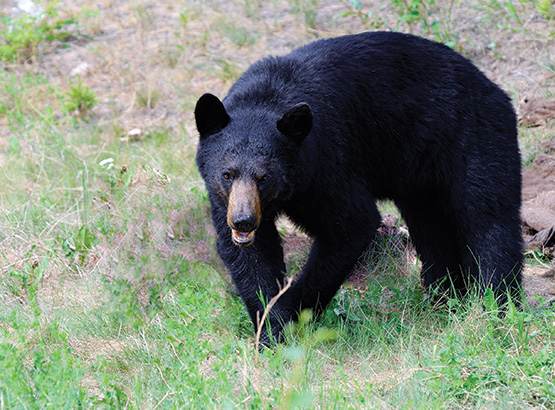Black Bear
Cubs are born during January in winter dens, usually in pairs, but larger litters are not uncommon. The cubs are very small and helpless at birth. Cubs emerge from the den in April and stay with their mother through the first summer and fall, denning with her their second winter. Female black bears in Arizona usually reach reproductive age in their fourth year, and usually breed every other year.

About
Black bears are the most common and widely distributed of the three North American bears. Historically, black bears occurred in all forested habitats in North America, including Mexico. The species has been extirpated from many eastern and mid-western states, but still occurs in 38 states, 11 Canadian provinces, and seven Mexican states.
In Arizona, the black bear is found in most woodland habitats, including pinyon-juniper, oak woodland, coniferous forest, and chaparral. An interesting footnote to black bear distribution in Arizona is the absence of any sizeable population of black bears north of the Colorado River.
Hunt History
After 1954, bear regulations became more restrictive, tags were required to take one, and in 1968 the black bear was again classified as big game. This designation was appropriate as hunter interest in the species was increasing. Hunt success varied with weather conditions and population vagaries, but annual bear harvests ranged from 131 to 313 for the years 1964 through 1980. Relatively few bears were taken under the stock-taking clause, most of them being taken by sport hunters. Concern about the bear’s relatively low reproductive rate caused the Department to monitor the bear harvest more closely.
Black bears are characterized as shy, secretive animals possessing considerable curiosity and displaying high levels of intelligence and exploratory behavior. Black bears are generally active in the early morning and late evening; they may alter their activity pattern to exploit sources of artificial food, becoming nocturnal at camp grounds and dump sites. Nuisance activities are nearly always associated with artificial food sources (beehives, campgrounds, and livestock).
Wildlife managers face tough decisions in human-bear conflicts

Our Mission
To conserve Arizona’s diverse wildlife resources and manage for safe, compatible outdoor recreation opportunities for current and future generations.
Hunt Regulations
Rules and regulations for hunting in Arizona.
Regulations for spring hunts, fall hunts and pronghorn, elk hunts.
